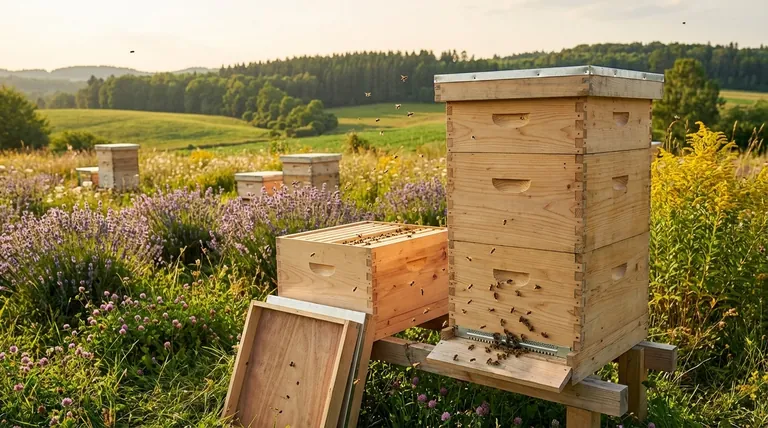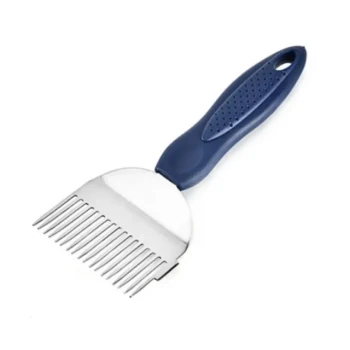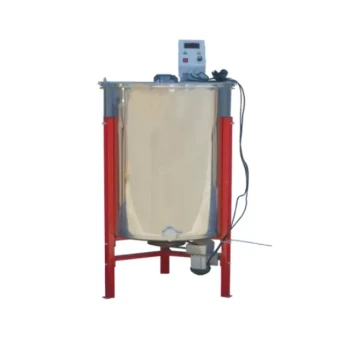At its core, the Langstroth beehive is a system designed for strategic expansion. Its primary method for supporting colony growth is its modular design, which allows a beekeeper to add boxes (called "supers") as the colony's population and resource needs increase. This prevents the hive from becoming overcrowded and gives the bees dedicated space for raising brood and storing honey, directly channeling their natural instincts into a productive and manageable system.
The Langstroth design's genius isn't simply about adding more room; it's about leveraging a deep understanding of bee behavior—specifically the concept of "bee space"—to create an orderly, inspectable, and expandable home that promotes colony health and productivity.

The Foundation: Bee Space and Modularity
The success of the Langstroth hive hinges on a single, brilliant observation made by its inventor, Reverend L.L. Langstroth, in 1851. This discovery changed beekeeping forever.
The Principle of "Bee Space"
Langstroth determined that bees will consistently leave a gap of approximately 5/16 of an inch (about 8 mm) open as a passageway. If a space is smaller than this, they will seal it with propolis (a resinous "bee glue"); if it is larger, they will build comb in it.
This "bee space" is the foundational principle of the entire hive. Every component is built to maintain this precise gap, ensuring frames are not glued together and comb is built only where the beekeeper intends.
A System of Interchangeable Boxes
The hive is not a single unit but a stack of interchangeable boxes. The bottom-most box is the brood chamber, where the queen lays her eggs and the colony raises new bees.
As the colony grows, the beekeeper adds honey supers on top. This vertical expansion provides a dedicated "pantry" for nectar storage, physically separate from the "nursery" below.
Removable Frames for Inspection
Within each box, precisely spaced frames hang like files in a cabinet. This design allows the beekeeper to remove and inspect any frame in the hive without destroying the surrounding comb.
This level of access is critical for monitoring colony health, checking for disease, assessing food stores, and confirming the presence and performance of the queen.
How Expandability Drives Colony Health
Adding space isn't just about making the hive bigger; it's a strategic management tool that directly influences the colony's behavior and long-term survival.
Preventing the Swarm Impulse
A crowded hive is the primary trigger for swarming, which is the colony's natural method of reproduction. When bees run out of space for brood and honey, they will raise a new queen and about half the colony will leave with the old queen to find a new home.
By adding a super before the hive becomes congested, the beekeeper relieves this pressure. This redirects the bees' energy away from swarming and toward continued population growth and honey production.
Channeling the Workforce
Providing empty supers gives the thousands of forager bees a place to deposit incoming nectar. Without this available space, foragers would have nowhere to offload their resources, leading to a "traffic jam" in the hive that slows down the entire operation.
Supporting Overwintering Success
A strong, populous colony with ample honey stores is essential for surviving the winter. The Langstroth system allows the beekeeper to ensure the bees can build up these critical resources in an organized way throughout the active season.
Understanding the Trade-offs
While highly effective, the Langstroth system is not without its challenges. Its benefits are directly tied to the active involvement of the beekeeper.
The Need for Active Management
The expandability of a Langstroth hive is not automatic. The beekeeper must learn to "read the bees" and know when to add or remove boxes.
Adding space too early can make it difficult for the colony to maintain temperature and humidity. Adding it too late can fail to prevent swarming. This requires regular inspection and good judgment.
The Physical Weight
A standard 10-frame deep box filled with honey can weigh over 80 pounds (36 kg), and even a medium super can exceed 50 pounds (23 kg). Managing a tall stack of these boxes requires significant physical strength.
Standardization vs. Natural Form
The Langstroth hive imposes a highly structured, rectangular geometry on the colony. While this is incredibly efficient for management and honey harvesting, it is different from the more irregular cavities bees would inhabit in nature. Beekeepers prioritizing a more "natural" comb structure may explore other hive types, like the Top Bar or Warre hive, which come with their own distinct management trade-offs.
Making the Right Choice for Your Goal
The Langstroth hive is a tool, and its effectiveness depends on how you use it in alignment with your beekeeping philosophy.
- If your primary focus is maximizing honey production and ease of inspection: The Langstroth's standardized, expandable design is the global industry standard for a reason.
- If your primary focus is supporting a healthy, growing colony: Adding space proactively before the bees become crowded is the most critical management task in a Langstroth hive.
- If your primary focus is minimizing physical strain: Consider using 8-frame equipment or using only medium-depth boxes for both brood and honey, as they are significantly lighter than 10-frame deeps.
Ultimately, the Langstroth hive provides a framework that allows you to work in partnership with your bees, guiding their natural instincts toward a strong and thriving colony.
Summary Table:
| Feature | Benefit for Colony Growth |
|---|---|
| Modular Supers | Allows vertical expansion, preventing overcrowding and swarming. |
| Removable Frames | Enables easy inspection for health, queen performance, and food stores. |
| Bee Space Principle | Keeps passages clear, ensuring bees build comb only where intended. |
| Separate Brood/Honey Chambers | Dedicated space for raising brood and storing honey maximizes efficiency. |
Equip your commercial apiary or distribution business for maximum productivity. The Langstroth hive is the industry standard for a reason. HONESTBEE supplies the high-quality, durable beekeeping supplies and equipment—from hive bodies and supers to frames and foundations—that commercial beekeepers and distributors rely on to build strong, thriving colonies. Let's discuss your wholesale needs and how our products can support your growth and success. Contact our team today for pricing and catalog.
Visual Guide

Related Products
- Langstroth Bee Hives Bee Keeping Box for Beginners Beekeeping
- Long Langstroth Style Horizontal Top Bar Hive for Wholesale
- Wholesales Dadant Size Wooden Bee Hives for Beekeeping
- Professional Insulated Plastic Bee Hives
- Automatic Honey Flow Beehive 4 Frame Mini Hive for Beekeeping
People Also Ask
- What are the different types of beehive boxes available? Choose the Right Hive for Your Apiary
- Should a beginner try a different type of hive? Start with a Langstroth for a solid foundation.
- Why might a beginner be advised to start with a Langstroth hive? Unlock a Supportive Beekeeping Ecosystem
- How does the ease of access differ between 8-frame and 10-frame hives? Choose the Right Hive for Your Body
- Why are Langstroth hives recommended for beginners? Unmatched Support & Standardization



















